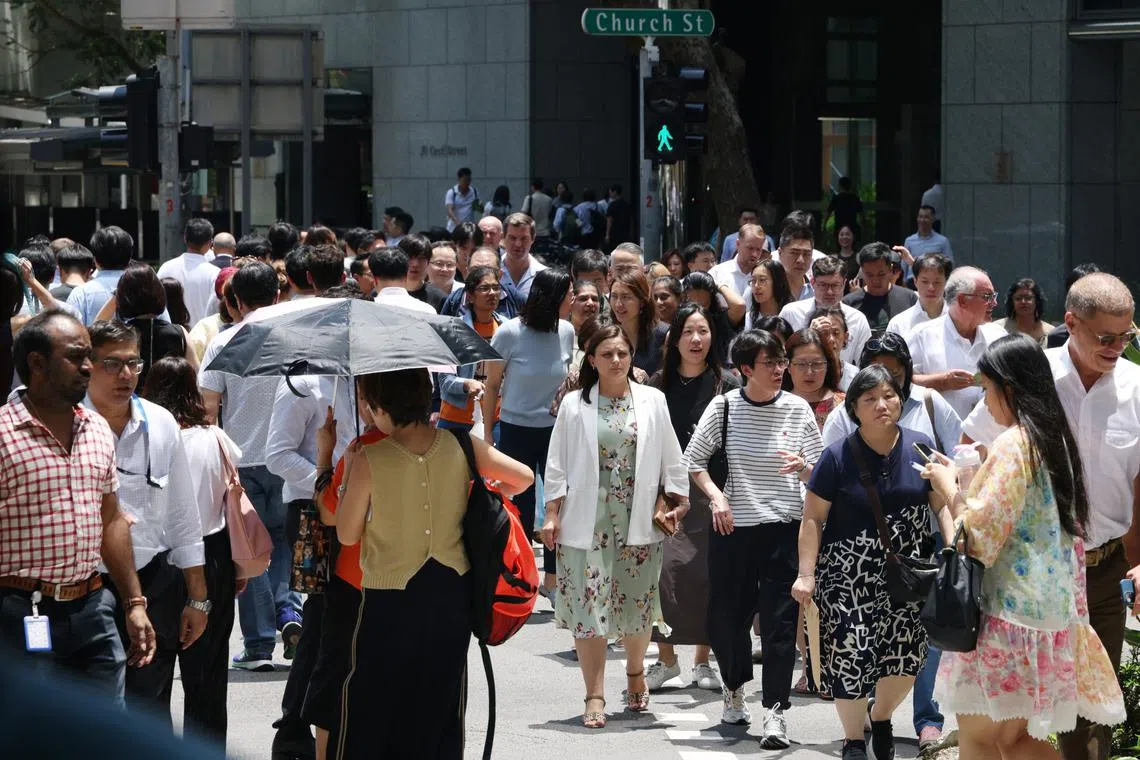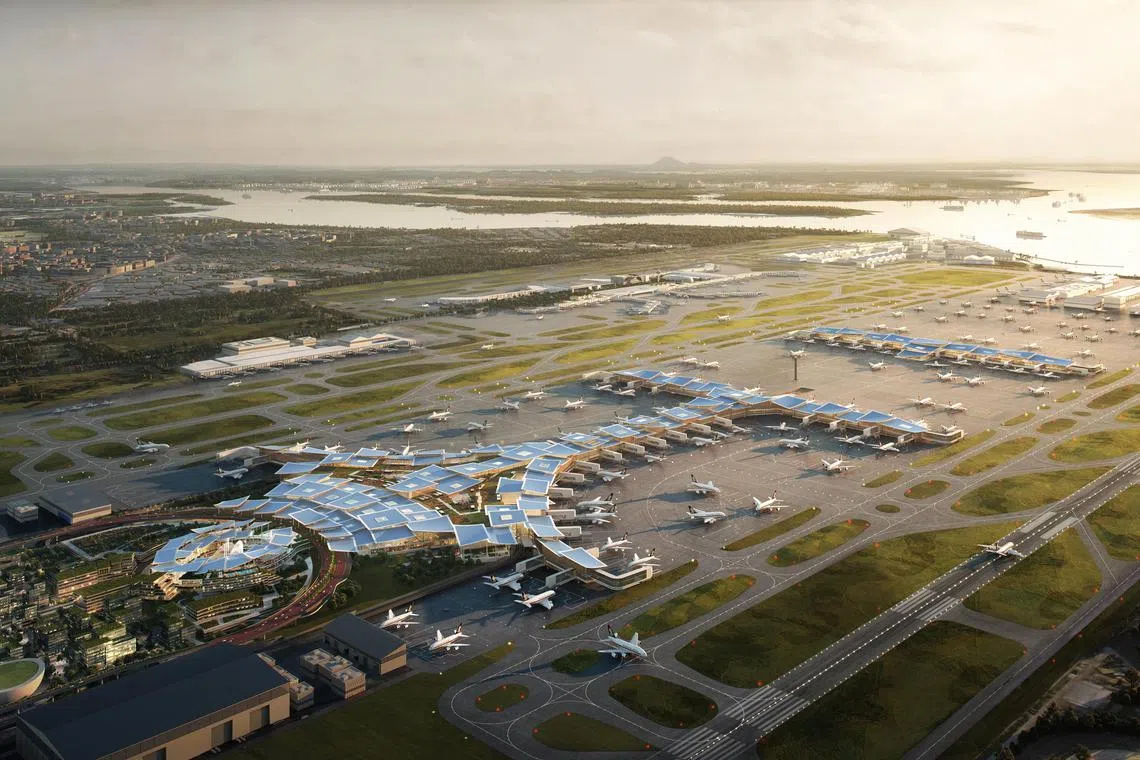Budget 2025 wish list: Carving a niche for Singapore on the global stage
Sign up now: Get ST's newsletters delivered to your inbox

Budget 2025 will be presented in Parliament on Feb 18.
PHOTO: ST FILE
Follow topic:
SINGAPORE – It is no surprise that the complex challenges threatening companies in Singapore as the country approaches its 60th year of independence form the bedrock of the business community’s extensive Budget wish list.
These challenges are many and varied, from rising operational costs and workforce shortages in the domestic market to an increasingly divided world.
And the ride is getting bumpier. Proposed US tariff hikes,
Mr Tan Tay Lek, corporate tax partner at PwC Singapore, said that small and medium-sized enterprises (SMEs) can be more vulnerable, especially without access to adequate funding, which is crucial for expansion.
SMEs are the backbone of Singapore’s economy, providing almost 50 per cent of the country’s gross domestic product and employing around 70 per cent of the local workforce.
There are around 300,000 companies here, of which 99 per cent are SMEs, with about 80 per cent of those locally owned.
Mr Tan said companies that lack resources find it hard to respond quickly to problems, which in turn hinder their growth and competitiveness, making targeted support essential for their survival and success.
So, it is no surprise that companies represented by groups such as the American Chamber of Commerce in Singapore and the Singapore National Employers Federation are asking for more government support and funding in Budget 2025.
Their wish list is long despite Budget 2024 providing for a 50 per cent corporate income tax relief
Budget 2025 will be presented in Parliament on Feb 18, and is likely to be the last for this Government, as the general election must be held before November 2025.
While budgets over the years were geared to supporting economic and social priorities as well as national development, Mr Tan said it is crucial the Government carve a niche for Singapore to play in the global arena and lay the foundation for future prosperity.
“We would like to see Budget 2025 address current economic, climate and global challenges, providing support for both businesses and workers, while setting the stage for enduring success,” he added.
“We also hope to see measures that create an environment conducive to innovation and technological progress, in addition to fostering long-term sustainable growth.”
Rising labour costs
Rising workforce costs remain the top concern for many businesses. The shortage of foreign workers affects sectors such as education, hotels, restaurants, construction and civil engineering, retail, health and social services, said Dr Faizal Yahya, senior research fellow at the Institute of Policy Studies at NUS’ Lee Kuan Yew School of Public Policy.
Companies in these industries want the Government to review foreign worker quotas and work permit regulations to address manpower issues.
The demand for skilled talent is especially high in finance and technology industries, with many employers struggling to find qualified candidates.
Mr Victor Mills, adviser to the board and interim chief executive of the Singapore International Chamber of Commerce, suggested that support similar to the Overseas Markets Immersion Programme (OMIP) for employees to gain overseas experience be extended to SMEs that have no international branches or offices.
“This is to allow such SMEs to give their Singaporean talent exposure to the overseas markets in which their companies have business,” Mr Mills said.
Under the OMIP, companies looking to send their employees overseas to gain experience can receive support for 70 per cent of a deployed worker’s salary and 70 per cent of their overseas allowance for up to nine months. These are capped at $5,000 and $3,000 respectively.

Rising workforce costs remain the top concern for many businesses.
ST PHOTO: JASON QUAH
High operational costs
Operational costs for businesses are high in Singapore, which is second only to Hong Kong as the most expensive city in the world for international workers, said Dr Faizal.
Costs include office rental, utility prices, logistics, including warehousing, distribution and transport, and fees for permits or licences for certain types of operations.
“These costs can significantly impact business profitability, limiting the company’s ability to invest in growth and innovation,” said Dr Faizal.
One subcontractor told The Straits Times that local suppliers like his with factories in Singapore tend to lose out to those that can source cheaper materials from China.
He cited the 63-storey development backed by Chinese internet giant Alibaba and partners as an example of a mega construction eyed by Singapore contractors. It was awarded on Feb 3, 2023 to China Harbour Engineering.
Another example was a subcontract for facade works for the Central Mall project, which was awarded on Aug 14, 2024 to Far East Facade Singapore, a subsidiary of China State Construction Development Holdings.
“We are not asking for protection but a more level playing field. Those of us who have invested heavily in factories here lose out,” the subcontractor said.
The next mega project that he and other subcontractors are eyeing is Changi Airport’s Terminal 5 (T5), where construction will start in the first half of 2025.
“T5 will be huge. It will be interesting to see how they are going to split the subcontracting jobs,” the subcontractor said.

An artist’s impression of Changi Airport Terminal 5, which is the next mega construction project that subcontractors are eyeing.
PHOTO: CHANGI AIRPORT GROUP
Small domestic market
Singapore’s small domestic market of six million poses challenges for businesses seeking substantial growth, often leading to fierce rivalry, as seen in the food and beverage space, Dr Faizal said.
KPMG’s Ajay Kumar Sanganeria, its head of tax, and tax partner Yong Jiahao said that expanding grants and financing options will enable businesses to integrate more effectively into regional value chains, sharpen competitiveness and strengthen cross-border partnerships.
“This approach will be especially beneficial in high-growth sectors such as digital and green economies, driving innovation and sustainability while positioning companies for success in the global market,” they said.

Singapore’s small domestic market of six million poses challenges for businesses seeking substantial growth.
ST PHOTO: GAVIN FOO
AI
Businesses recognise the need for digital transformation, but they face high costs related to the adoption of artificial intelligence (AI) and the upskilling of employees.
Budget suggestions ranged from continued funding through the SkillsFuture Enterprise Credit, increased Absentee Payroll Funding to offset training costs and extending the Senior Employment Credit beyond 2025 to help employers hire and retain older workers.

Businesses recognise the need for digital transformation, but they face high costs related to the adoption of artificial intelligence (AI) and the upskilling of employees.
PHOTO: LIANHE ZAOBAO
The Government should encourage the adoption of tech enablers to help businesses remain competitive, while expanding existing grant programmes to ease financial, infrastructure and talent constraints for SMEs, KPMG experts said.
There is also a pressing need to support AI governance training and certification to help establish best practices, fostering responsible and effective AI adoption, they added.
Greater support is also needed to help SMEs go green, with KPMG noting: “Hard-to-abate industries such as heavy industry, aviation, maritime and transport are particularly likely to require targeted assistance.”
Ms Ling said there needs to be a balance in the Budget when addressing current issues and growth strategies.
“The here and now mainly revolves around costs and manpower and market access. However, the future strategies would require embracing growth tools and areas like AI, fintech, digital adoption and sustainability initiatives,” she said.
“For SMEs, the latter may be less tangible and require significant bandwidth and resources.”


